Dr. Jeff Duke, founder of 3Dimensional Coaching®, shares the most effective way to motivate athletes.
“Mom and Dad, the most important thing I can say is this football program has prepared me for adversity. Every day is a minefield. You never know when it’s going to hit, and you never know how big or how small. But I can say for sure that I’m prepared. I’m thankful my family allowed me to play this great sport, and I’m thankful I’ve been a part of it. … This program has also helped me learn that being a man is not about being tough or mean. It’s about loving one another and living your life for the glory of something bigger than yourself. … Now it’s time for me to move on to the next chapter of my life, but I will always be thankful for football, as well as the coaches. Coach taught me what being a man is really about.”
Dr. Jeff Duke loves to share this letter. It’s one of many he’s read over the years as the founder of the 3Dimensional Coaching® framework (also called 3D Coaching) that is revolutionizing the coaching landscape around the world.
Shared by a high school senior to his parents at the team’s end-of-the-season banquet, this heartfelt letter provides an example of an athlete who found motivation from within instead of without. With guidance from his coach, he will now carry this life-changing lesson—one of intrinsic motivation—beyond sports and into his future being less inclined to chase the next and better thing and more ready to fulfill the calling of Christ to simply love God and others.
What the letter also shows is that the athlete’s coaches were successful in motivating their athletes beyond the typical and temporary rewards of sports.
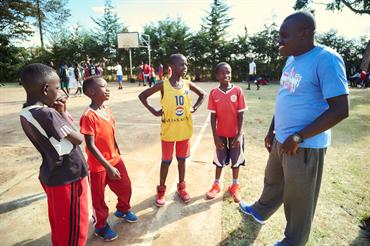
Defining Motivation
According to Dr. Duke, who, in his time with 3D Coaching, has compiled mountains of research, motivation must be broken down into two parts: pursue and persist.
Pursue = I want it.
Persist = I want to stay after it.
“Motivation has to be ongoing; it’s not a one-and-done thing,” said Dr. Duke. “In today’s culture, we obviously hope kids want to play well. We want them to give their all, and we want them to continue doing that as they go through the circumstances sports present.”
Once motivation is defined as “pursue and persist,” Dr. Duke then breaks motivation into two categories: extrinsic and intrinsic.
Extrinsic Motivation
Extrinsic motivation means motivating athletes with something outside of themselves. Their thoughts become, “I am motivated to pursue and persist as long as I get what culture says I deserve.” Easily seen and measured, extrinsic motivators include just about everything one would think it does:
-
championships
-
scholarships
-
trophies
-
personal records
-
money
-
gear
-
records
According to Dr. Duke, there is absolutely nothing wrong with any of those things in and of themselves; they simply aren’t the most beneficial ways to motivate athletes in the long run.
Intrinsic Motivation
Intrinsic motivation, on the other hand, is less easily measured. Hard to define, but easily seen, it is often recognized when a team “plays with great heart,” or when an athlete competes with a sense of curiosity and wonder.
One way Dr. Duke explains intrinsic motivation is by using the example of a painting. The art itself can’t be seen until it is brushed onto a canvas. It’s a masterpiece that lives only inside the painter and can only be seen and valued after he or she expresses it.
Intrinsic motivators are the emotions, beliefs, values—things that aren’t visible on a stat sheet. And according to Dr. Duke, when it comes down to which is the more effective (and beneficial) motivation style, intrinsic beats extrinsic 10 times out of 10.
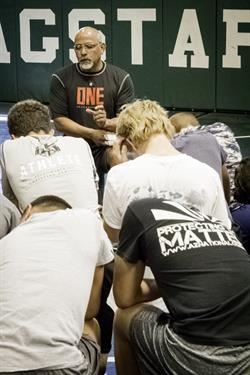
Extrinsic vs. Intrinsic
“We’re not saying extrinsic motivation is wrong,” Dr. Duke said. “We’re saying it needs to become a blessing. It needs to become the icing on the cake, not the cake itself.”
But why? Why is intrinsic so much more effective over extrinsic when motivating athletes?
For one, allowing extrinsic motivation to drive an athlete isn’t safe.
“With extrinsic motivation, nothing will ever be enough,” Duke emphasized. “There will always be one more championship, one more ring, one more thing to chase. And if you continue to drive that way, it’s going to cause issues of identity in your life.”
If athletes pursue extrinsic motivations long enough, they eventually begin to internalize them. According to Dr. Duke, research shows that the athlete’s brain will begin to communicate to them specifically that playing sports will get them something, thus leading them to only play sports to get something out of it. “An athlete who pursues the next best thing through athletics” becomes who they are…their identity.
The problem then becomes evident when sports end.
According to Dr. Duke: “By the time people are between ages 17 and 22, they’re predominantly done playing sports in our country, excluding the microscopic number of athletes who play professionally. But since age 7, these athletes were coached to pursue the external world of sport, and now, all of a sudden, it’s gone. And, boy, when their identity falls apart, they need help.”
This help often comes in the form of anti-anxiety and anti-depressant medication. Statistically, the usage of these meds increases in men and women who had been involved in sports since they were young when they reach their early 20s.
Said Dr. Duke, “We’re destroying kids with extrinsic motivation as the primary driver.”
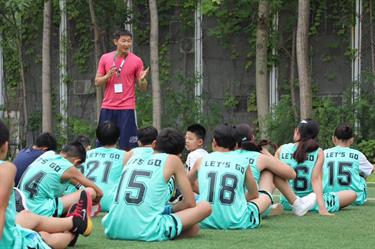
Biblical Basis for Motivating Athletes
On the flipside, athletes driven by intrinsic motivators have been shown to not only to be less likely to fall apart when they don’t get the trophy or when athletics end, but they also play at their very best while they are competing. One motivator in particular has been shown to stand out above the rest: joy.
"When you look through the Bible, you see that the greatest motivator of all time is the emotion of joy,” Dr. Duke said. “If you ever do anything with joy, I don’t care what it is, the research says you will do it at your very best. It’s the most effective motivator there is. And we know from Scripture that joy is rooted in love, and it can only be revealed when you see it happen.”
Christ was Motivated by Joy
Consider Jesus from Hebrews 12:2: “For the joy set before him He endured the cross, scorning its shame, and sat down at the right hand of the throne of God.” The joy that carried Jesus through the crucifixion was rooted in His love for the Father and for us. Joy was Jesus’ intrinsic motivator, enabling the greatest event in history to take place and ultimately leading to our salvation and ability to have direct access to the Father.
And it’s is the same intrinsic motivator that, according to research, will enable athletes to play to the very end and at their very best. Joy helps athletes avoid the common extrinsic traps of burnout, entitlement and inevitable identity crisis once competition is over.
Love for the Win
Joy and love. Sound soft? Sound easy to beat when the opponent has a seemingly perfect extrinsic carrot dangling in front of them?
“This isn’t just holding hands and singing Kumbaya,” Dr. Duke said. “Love can be tough. When you love somebody, you can get in their grill. You get after them because love is always a unifier; it draws people in. The difference is that love never has an ‘ugly’ end to it. It just continues to grow in beauty—the art of coaching.”
Every coach knows the scoreboard can’t be disregarded. They have to pursue greater performance and wins. That’s sports. But when those extrinsic rewards become byproducts of joyful, loving athletes who are performing well because of their deep love of God, their teammates, their coaches and the game itself, that’s when the real wins happen.
“An intrinsically motivated athlete will run through a wall for their coach,” Dr. Duke said. “So, when this happens, you’re gaining everything performance-wise, but you’re also gaining something even bigger. It’s the attribution effect—that what I do today, how I coach, will affect people both today and in the future. That’s the beauty of joy. It really makes a difference in kids’ lives.”
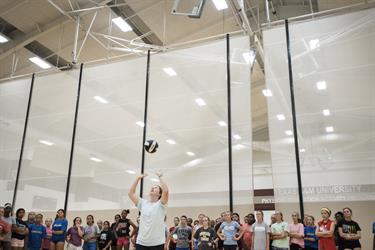
Motivating Athletes in a Healthy Environment
The idea of coaching athletes to operate out of intrinsic motivation doesn’t come as naturally as coaching them using extrinsic motivation. It’s easier (and culturally recommended) to offer the next greatest reward as the driver for peak performance.
Helping athletes compete out of joy, curiosity, wonder and love involves setting an environment in which these things can naturally flow. Dr. Duke goes back to the analogy of the painter to explain how this can be done: Set the artist in a beautiful environment with a canvas and watch the art become a natural expression.
In his years with 3D Coaching, Dr. Duke has helped thousands of coaches develop strategies for facilitating intrinsic motivation, and he has a number of favorite examples:
Don’t give out awards at banquets.
The public will do a great job of affirming the team’s top athletes, and many will get league awards and recognition in the media. So, for team banquets, coaches can focus on the intrinsic. Remember the letter from the high school senior football player? That athlete was asked to take an internal look and discover what he learned that would help him for the rest of his life. The parents and coaches were also affirmed in the process. No awards were necessary.
Serve with your team.
One coach takes his team to serve underprivileged kids for a week during spring break. According to the coach, it’s the number one motivator for his team all year, as it unites the team as “one.” Why? Again, the difficulty lies in the inability to measure intrinsic motivation, but “it just feels good.” When coaches help instill a sense of curiosity and novelty through serving together, it adds value and gives meaning to their athletes’ lives.
Go to FCA Camp.
According to Duke, the power of FCA Camp is not that athletes get to increase their sports skills, (though that is a good reason!). The power lies in being in community and in learning to love Christ and others.
More examples exist, which is a good thing. It’s in the nature of coaches to replicate what works for others in their profession, and the same can apply to coaching intrinsic motivation.
Said Dr. Duke: “They just need to see it being done by others. It’s funny because being in school, you get in big trouble for copying off of someone else, but in coaching, it’s how we do business. We go to a clinic and say, ‘Man, I love that play or that drill,’ and we immediately go back and put it in our playbook. That’s one thing we do to help coaches with intrinsic motivation. We help them see it, go through it and watch others. And that’s what helps it spread.”
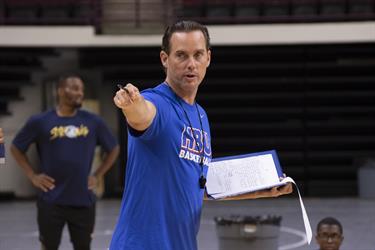
Becoming a 3D Coach
Perhaps one of the most important keys for coaches to understand is that motivation actually begins inside of them. Athletes will buy into whatever their coaches express. An extrinsically motivated coach who focuses on getting athletes to the next level will produce athletes motivated by rewards. An intrinsically motivated coach who recognizes his or her calling to positively impact athletes’ lives will help them recognize that there is more to sports than wins and losses.
3Dimensional Coaching is a resource that helps coaches identify their “why” for coaching and embrace their calling to impact others.
“When I realize I impact people beyond the playing of the game, that’s a wow moment,” Dr. Duke said. “Every coach will make an impact; that’s not a question. It’s whether that impact will be one of beauty or be ugly. So, we try to help coaches realize their impact and start asking internal questions of why they do what they do. Then 3D Coaching and FCA come alongside them through discipleship, nurturing and walking with them.”
To become a 3D Coach, Dr. Duke emphasizes that coaches need to distinguish the differences between a job, career and calling.
“A job is something you do to make money to pay for needs in your life, and that’s good. We all need to work. And a career is just a job you’ve had for a long time. But a calling is, ‘Wow, what I do actually impacts others.’ And the impact can be incredible.”
Learn more about 3Dimensional Coaching
Coaches, do you want to help your athletes develop intrinsic motivation? Do you want to maximize the impact you have on them beyond the game? Check out 3D Coaching by visiting https://www.fcacoachesacademy.com (faith-based version) or https://3dinstitute.com.
-FCA-